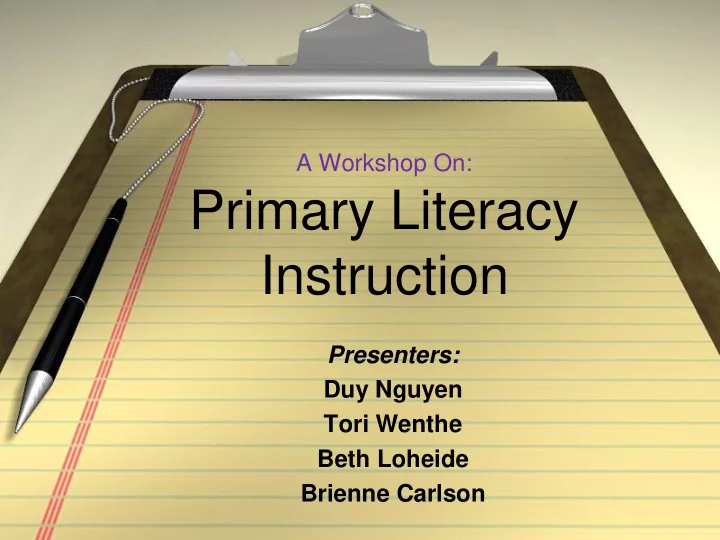

A Workshop On: Primary Literacy Instruction Presenters: Duy Nguyen Tori Wenthe Beth Loheide Brienne Carlson
Authentic Reading and Writing Powerful message Value of literacy “The first and most basic component of classroom instruction is offering children a variety of real reading and writing encounters.” – Classrooms that Work by Cunningham & Allington
Key Elements of Literacy Instruction Comprehension Concepts of Print Fluency High Frequency Words Literacy Appreciation Phonemic Awareness Phonics Reading Strategies Vocabulary/Concept Development
Comprehension What it is Why it is important to teach
Reading Comprehension Strategies (Estrategias de la comprensión lectoral) • Monitor Comprehension (Observar la comprensión) • Activate and Connect (Activar y conectar) • Ask Questions (not just answer) (Hacer preguntas-- no sólo respuestas) • Infer and Visualize (inferir y visualizar) • Determine Importance (determinar la importancia) • Summarize and Synthesize (resumir y sintetizar)
Monitor Comprehension “Keep track of your thinking as you read, listen, and view.” (Seguir sus pensamientos mientras lees, escuchas y miras.) Para los lectores For proficient readers eficientes, ésto es this comes naturally natural
Concepts About Print What they are: • Print carries a message • Directionality, differences between letters and words, distinction between upper and lower case letters and punctuation. • Books have common characteristics (e.g. author, title, front/back) Why it is important to teach: • Fundamental understanding
Fluency What it is: Rhythm and melody of text Why it is important to teach: Construction of meaning
High Frequency Words What they are: • Occur often in oral and written language • May or may not be phonetically decodable Why they are important to teach: • Aids fluency and comprehension
Literacy Appreciation What it is: • Appreciating literary qualities • Recognizing and responding to writing (imagery, author’s voice, genre, structure, etc.) conveys meaning Why it is important to teach: • Using higher level thinking skills to analyze, synthesize, and evaluate • Personal response to writing
Phonemic Awareness What it is: • Spoken words are made of sounds • Ability to pick out, segment, manipulate and blend sounds in spoken words Why it is important to teach: • Before learning phonics • Hearing tasks rather than reading tasks
Phonics What it is: Understand correspondence between letters and sounds with goal of blending Why it is important to teach: Blending sounds together accurately and automatically is a critical step
Reading Strategies What it is: • Problem-solving behaviors • Visual print, structure, meaning and pictures Why it is important to teach: • Allows children to become independent
Vocabulary/Concept Development What it is: Knowledge of word meanings and the concepts they represent Why it is important to teach: Reading comprehension depends upon the reader’s recognition of words
Balanced Literacy Framework Reading Writing Read-Aloud Modeled Writing Shared Reading Shared Writing Guided Reading Interactive Writing Independent Reading Independent Writing
Gradual Release of Responsibility
Stages of Writing Development Emergent Early Conventional
Emergent Writer
Big Ideas in Writing PreK-5 “Scribbles” tells a story. Most primary form of writing. Finger spacing between words Letters to represent sounds, words made of sounds Writing left to right Sentence structure (capital letter, ending punctuation, has an action) Generating ideas from our own lives (small moments) Clear beginning-middle-end Paragraphing with topic sentence and supporting details Using effective story leads and endings Use Mentor Texts to model our writing after Use a Writing Cycle: pre-write, plan, write, revise, edit, publish, share (not every piece is published and we focus on editing one or just a few conventions. Goal is not to fix everything each time.
6 Traits- Qualities that define good writing: Ideas- from the heart Organization- logical pattern of ideas Voice- personal tone and conviction of the author Word Choice- the vocabulary chosen conveys a precise meaning Sentence Fluency- has a rhythm and flow Conventions- mechanical correctness- (not as important K-2 as other ideas)
Thank You! ¡Gracias!
Recommend
More recommend